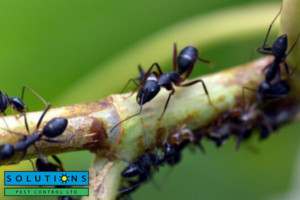Spotting large black ants in your home, especially near wood or moisture-prone areas, can be alarming. If these ants are carpenter ants, you could be facing more than just a nuisance; they may be damaging the structure of your home from the inside out. While they don’t eat wood like termites, carpenter ants burrow through it to create their nests, weakening wood over time.
If you’re currently dealing with a carpenter ant issue, knowing how to get rid of carpenter ants effectively is crucial. This guide breaks down how to identify them, what attracts them, and what steps you need to take immediately to protect your property.
What Are Carpenter Ants?
Carpenter ants are one of the largest ant species in North America. Typically black or dark reddish in color, they range from 6 to 12 mm in size. These ants prefer moist, decaying, or hollow wood, where they excavate galleries to build their colonies.
Unlike termites, carpenter ants do not consume wood. Instead, they hollow it out for nesting. Over time, this can cause serious structural damage, particularly if the infestation goes unnoticed or untreated.
Signs of a Carpenter Ant Infestation
Identifying an infestation early is key. Here are the most common signs of carpenter ants in your home:
- Large, winged ants indoors: These are reproductive ants, or swarmers, usually seen in spring or early summer.
- Rustling sounds: You may hear faint rustling noises coming from walls, ceilings, or wooden furniture.
- Frass: Carpenter ants push out wood shavings and debris (called frass) from their nests. If you see piles of this material, it’s a strong indicator of nesting activity.
- Visible ants: Spotting large black ants, especially in kitchens, bathrooms, or around windows, could signal a nearby nest.
- Soft or damaged wood: If wooden structures sound hollow when tapped, carpenter ants might be to blame.
What Attracts Carpenter Ants to Your Home?
Carpenter ants are drawn to certain environmental conditions that make homes a prime target:
- Moisture: Leaky pipes, roof leaks, and condensation provide ideal nesting sites.
- Rotting or damp wood: They prefer soft, water-damaged wood over dry, solid lumber.
- Food: While they don’t eat wood, carpenter ants forage for sweets, proteins, and grease inside your home.
- Tree branches touching the house: These can serve as bridges for ants to enter from outside.
Immediate Steps to Take
If you suspect or confirm a carpenter ant problem, here’s what you should do right away:
1. Identify the Source
Look for trails of ants, signs of frass, and moisture-prone areas. Carpenter ants usually nest near water sources, so inspect kitchens, bathrooms, basements, and areas near window frames or leaky roofs.
2. Eliminate Moisture
Fix any plumbing leaks, dry out wet wood, and use dehumidifiers in damp spaces. Reducing moisture makes your home less appealing to ants and helps prevent future infestations.
3. Trim Vegetation
Cut back tree branches, bushes, and other vegetation that touch your home. These act as pathways for carpenter ants and other pests.
4. Seal Entry Points
Use caulk or weatherstripping to seal cracks and gaps around windows, doors, and foundation walls. Blocking entry points can reduce indoor access for foraging ants.
5. Remove Food Sources
Store food in airtight containers, wipe down kitchen counters, and clean up spills and crumbs. Also, don’t forget about pet food and garbage bins—keep them sealed and clean.
6. Use Baits and Dusts (With Caution)
Some over-the-counter carpenter ant killer products can help reduce visible ant activity. However, these should be used with care. If used incorrectly, they may scatter the colony rather than eliminate it. Baits must be slow-acting so ants carry the poison back to the nest.
Keep in mind: DIY treatments rarely reach the main colony, especially satellite nests located in hard-to-reach places like wall voids or attic beams.
7. Call a Professional
Carpenter ants are persistent and can be difficult to eradicate without expert help. A licensed pest control technician will inspect your home thoroughly, locate nests (primary and secondary), and apply targeted treatments safely and effectively.
Partnering with a trusted pest control North Vancouver service is the most efficient and long-lasting solution.
The Importance of Professional Treatment
Professional pest control companies use advanced methods that go beyond surface-level treatments. They can identify nesting sites using moisture meters, thermal imaging, or other tools. Depending on the severity of the infestation, treatment may include baiting, drilling and dusting wall voids, or applying residual insecticides around your home’s perimeter.
Additionally, experts offer guidance on how to prevent reinfestation through environmental modifications and ongoing monitoring.
Carpenter ant infestations often involve multiple satellite nests, especially in larger homes. Without professional-grade products and strategies, complete eradication is difficult to achieve on your own.
Prevention Tips for the Future
Even after the ants are gone, taking preventive steps will help ensure they don’t come back:
- Inspect your home regularly for signs of water damage or leaks.
- Store firewood away from your home and keep it elevated off the ground.
- Keep gutters clean and make sure downspouts direct water away from the foundation.
- Repair damaged or rotting wood immediately.
- Consider a seasonal inspection from a North Vancouver pest control expert to catch early signs of reinfestation.
Don’t Ignore the Problem
While carpenter ants might seem like a minor inconvenience at first, the structural damage they can cause is no small issue. Left untreated, their tunneling can weaken walls, ceilings, and support beams, leading to costly repairs. Acting fast by eliminating moisture, securing your home, and calling in professional help is the smartest way to protect your investment.

About Solutions Pest Control
At Solutions Pest Control, we specialize in helping Vancouver-area homeowners tackle tough pest problems, including carpenter ants. Our team of trained professionals understands the unique pest pressures in the region and provides thorough inspections, tailored treatment plans, and long-term prevention strategies.
Whether you’re dealing with an active infestation or want to protect your home from future invasions, Solutions Pest Control has the tools and experience to help. We take a strategic and eco-conscious approach to pest management, prioritizing your safety and peace of mind. For trusted local protection, rely on our expert pest control Whistler BC services.


